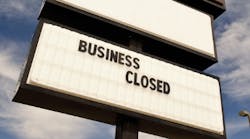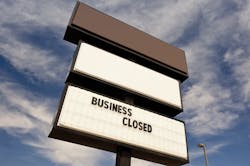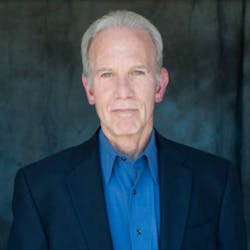The disappearing solo practice model in dentistry
Opinion-Editorial
A model disappears when it becomes obsolete. A model becomes obsolete when it reaches the end of its life cycle. I assert that the life cycle of solo practice in dentistry is ending. (1,2)
The definition of obsolete is "no longer in use or no longer useful; of a kind or style no longer current." (3) According to this definition, solo practices are becoming obsolete. Many of those in solo practice won’t believe this. They will deny, disclaim, and strongly resist the idea that they are the last of their kind. But solo are like pen and paper, hard drives, car keys, checkbooks, landlines, passwords, desktop computers, cabs, portable music players, and retail stores—all things that are are becoming obsolete.
When you examine the obsolescence phenomenon, there are many clear indicators that it’s happening in dentistry. One sign of impending obsolescence is bad forecasting. (4,5) Solo practitioners are, of course, forecasting their longevity. Why is this? One reason is that many in solo practice don’t see the tremendous shift in consumer demands.
Consumers today are very different from consumers just a decade ago. People now live in a digital world, and this has transformed what it means to be a consumer. Today, the dental consumer is concerned with immediate access, convenience, clear pricing, transparency, and efficiency. Consumers are seeking digitally validated quality—not a connected personal relationship with a dentist. They want digital assuredness over unconfirmed trust. (6) Dental consumers want fast, easy transactions with simple digital connections, such as when they want to schedule an appointment. They demand greater knowledge about recommended treatment, as well as links to explain and demonstrate the available procedures. Soon there will be a way for dental consumers to self-diagnose using intraoral scanners. The point is, considering patients the same way as 10 years ago is foolish.
Another sign of solo practice obsolescence is how managed group practices and dental support organizations (DSOs) are eating solo practices’ lunch. The market share of DSOs has rapidly expanded while many solo practices have struggled. DSOs can deliver dental care for less per patient and with greater convenience than solo practices. DSOs can buy supplies and materials for less than solo practices. DSOs can recruit and hire better staff and associates than solo practices. DSOs can gain far better leverage in transactions with suppliers, vendors, and lenders than solo practices. Suffice to say, there are distinct strategic and financial advantages in being a managed group practice rather than a solo practice, and those advantages are expanding. (8,9)
Another sign is that solo practices can’t handle the increasingly complex systems that modern dentistry demands. Complexity is increasing in nearly every domain of dental practices, including patient management, clinical care, diagnostics, treatment planning, materials and methods, financing, digital laboratory transactions, and practice analytics. Nearly everything in the dental practice has become multifaceted and granulated, requiring more knowledge and greater digital capacity. Solo practices’ legacy systems can’t keep up, while updating existing systems is costly. (10)
Expenses are going up across the board for dental practices, and solo practices' financial struggles will intensify, putting more and more pressure on ownership and support staff. If you can’t keep up, you can’t endure.
Because they can’t scale, solo practices have great difficulty improving their margins. They have limited space, locked in by leases or building ownership. They can gain some efficiencies and increase hours, but that is limited. It costs a lot to run a practice, and costs are going up each year. One of those steadily increasing costs is staff. Larger entities can offer robust benefit packages, promotion pathways, profit sharing, CE, and better pay scales than solo practices. (11,12) The same goes for recruiting and retaining associates.
Solo practicing dentists are dentists. They are not trained business professionals. They don’t see things with the same eyes as a seasoned CFO, COO, or a VP of marketing. As complexity increases, practices need more talent and skill to manage the changes inherent in complex systems. A solo practitioner makes his or her money in the operatory, not in front of the computer screen or group meetings. Professional management is not available to solo practice (given costs), but is part of the structure of managed group practices and DSOs. The level of management and accountability in the vital areas of practice are under professional purview, whereas in solo practice they are under the harried eye of the overwhelmed practitioner-owner.
Being overwhelmed leads to high stress, which leads to burnout and health issues. (13,14) In solo practice, the practitioner-owner has to be solely accountable for every portion of the practice, but in a managed group there are specialists for every area of the business—including a director for clinical care. Under this model, dentists can focus on dentistry, leaving the management of administration, clinical staff, marketing, and finance in others' hands, resulting in less stress.
Solo practices cannot offer powerful visionary leadership—leadership that passionately declares a future for the enterprise that is inspiring for patients, community, staff, and associates. (15) The best that a solo practice can offer is more of the same, which is not an inspiring future. (16) More of the same translates into the staff seeing they have a very limited future with little room for professional or personal growth and development.
Working all day in the operatory and then spending any remaining minutes on managing the particles of a business leaves little or no time for visionary leadership. But in managed groups, visionary leaders are at the helm. They bring passion and purpose, as well as new and exciting opportunities for the enterprise and its people.
Solo practice doesn’t have the time for addressing underlying problems and concerns of its staff that if left unaddressed can stymie or even sabotage a practice. Leaving these issues for an already stressed office manager to handle—someone who has received little training in mediation and intervention—is unwise. And the way solo practice is set up, the dentist-owner needs to be in the operatory making money. Making matters worse, most dentists are conflict averse. In managed group practices, a good senior, nondental executive—whether a COO or HR member—is trained to address and handle conflict, staff skirmishes, or disgruntled employees, so that issues do not swell under the surface. (17)
Lastly, dentistry is becoming part of primary care. The dentist-owner and the staff will be responsible for performing many more activities in overall patient health care, not just oral care. (18) Given the meager reimbursement for many standard medical procedures, such as recording vital signs, and the increased complexity of doing dental care in coordination with systemic issues, another hefty weight will be loaded onto solo practices. Managed groups can afford nurse practitioners to handle these duties.
The reported findings from the American Dental Association (ADA) are that solo practices are disappearing at a rate of 7% per year. (19) In my view, this percentage will increase every year as group practices extend their reach and breadth. And with nearly all new dental graduates and residents not wanting to own solo practices for multiple reasons, the solo practice as an asset will continue to go down in value.
Future changes and trends are noticeably occurring in the dental industry, and these future changes are causing upheaval in the dental ecosystem. Solo practice was once the top of the food chain in dentistry, but they are now being threatened by the many changes that are occurring. Managed group practices and DSOs are moving to the top of the food chain, pushing and shoving solo practice downward. The ecosystem will change so dramatically over the next decade, that the extinction of solo practice is likely.
References
1. Levitt T. Exploit the product life cycle. Harvard Business Review website. https://hbr.org/1965/11/exploit-the-product-life-cycle. First published in November 1965.
2. Solomon R, Sandborn P, Pecht M. Electronic part life cycle concepts and obsolescence forecasting. University of Maryland website. IEEE Trans. on Components and Packaging Technologies. http://enme.umd.edu/ESCML/Papers/ObsCPMT.pdf. Published December 2000.
3. Definition of obsolete. Merriam-Webster website. https://www.merriam-webster.com/dictionary/obsolete.
4. Rithholtz B. 10 points about forecasting and why we stink at it. Bloomberg website. https://www.bloomberg.com/view/articles/2017-11-01/10-points-about-forecasting-and-why-we-stink-at-it. Published November 1, 2017.
5. Fox J. How to be bad at forecasting. Harvard Business Review website. https://hbr.org/2012/05/how-to-be-bad-at-forecasting.html. Published May 11, 2012.
6. Simpson J, Ohri L, Lobaugh KM. The new digital divide: The future of digital influence in retail. Deloitte Insights website. https://www2.deloitte.com/insights/us/en/industry/retail-distribution/digital-divide-changing-consumer-behavior.html. Published September 12, 2016.
7. Bolen A. Seven characteristics of the modern consumer: Leaders from eBay, Chico’s and Brooks Brothers describe today’s shoppers. SAS website. https://www.sas.com/en_us/insights/articles/marketing/modern-consumer.html.
8. Post J. The future of DSOs: Technology, performance, and growth trends. DentistryIQ website. https://www.dentistryiq.com/articles/2017/05/the-future-of-dsos-technology-performance-and-growth-trends.html. Published May 15, 2017.
9. Cooper M. Why the future is DSOs. Dental Products Report website. http://practicemanagement.dentalproductsreport.com/article/why-future-dsos-0. Published April 19, 2017.
10. Schneider A. When companies become prisoners of legacy systems. Wall Street Journal website (sponsored article). http://deloitte.wsj.com/cio/2013/10/01/when-companies-become-prisoners-of-legacy-systems.
11. Elsenpeter R. The top 9 benefits of DSOs for dentists. Dental Products Report website. http://www.dentalproductsreport.com/dental/article/top-9-benefits-dsos-dentists?page=0,5. Published March 3, 2017.
12. Rabinowtiz E. Weighing the pros and cons of dental service organizations. Dentist’s Money Digest website. http://www.dmdtoday.com/news/weighing-the-pros-and-cons-of-dental-service-organizations. Published January 4, 2018
13. Wasoski RL. Stress, professional burnout, and dentistry. J Okla Dent Assoc. 1995;86(2):28-30.
14. Rada R, Johnson-Leong C. Stress, burnout, anxiety and depression among dentists. Journal of the American Dental Association webiste. https://pdfs.semanticscholar.org/8c2d/80a2c77fd9d4e210f66cc5a822bac4ff7620.pdf. Published June 2004.
15. 4 essential characteristics of visionary leadership. RisePrograms.com website. http://riseprograms.com/rise/2017/10/16/4-essential-characteristics-of-visionary-leadership/.
16. Mustapha Z. 5 non-negotiable attributes of visionary leadership. HuffPost website. https://www.huffingtonpost.com/zak-mustapha/5-nonnegotiable-attribute_b_11582196.html. Published August 19, 2017.
17. Lubin J. The high cost of avoiding conflict at work. Wall Street Journal website. https://www.wsj.com/articles/the-high-cost-of-avoiding-conflict-at-work-1392390289. Published February 2014.
18. Whtiman E. Moving dental health into primary care. Modern Healthcare website. http://www.modernhealthcare.com/article/20170107/MAGAZINE/301079949. Published January 7, 2017.
19. Guay A, Wall T. Considering large group practices as a vehicle for consolidation in dentistry. American Dental Association website. https://www.ada.org/~/media/ADA/Science%20and%20Research/HPI/Files/HPIBrief_0416_1.pdf?la=en. Published April 2016.
Editor's note: This article first appeared in the Apex360 e-newsletter. Apex360 is a DentistryIQ partner publication for dental practitioners and members of the dental industry. Its goal is to provide timely dental information and present it in meaningful context, empowering those in the dental space to make better business decisions.
Subscribe to the Apex360 e-newsletter here.
Dental news and press releases may be sent to Apex360 editors at [email protected]">[email protected].



